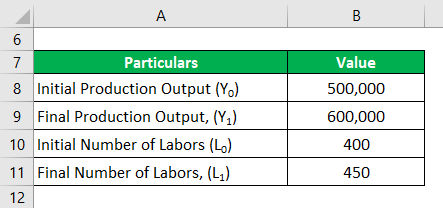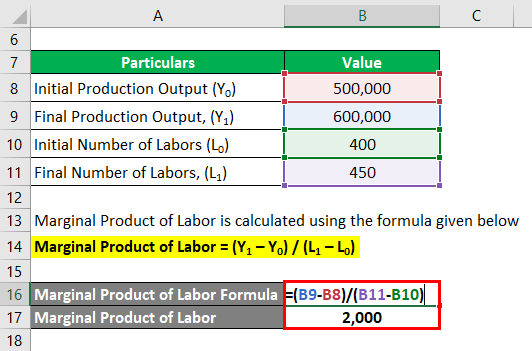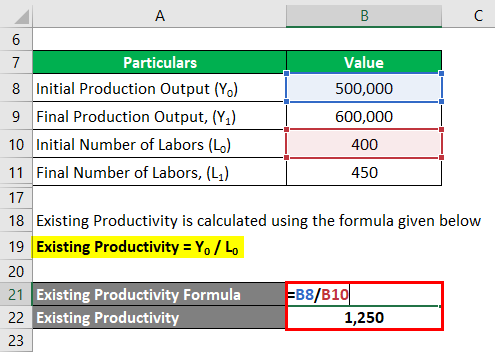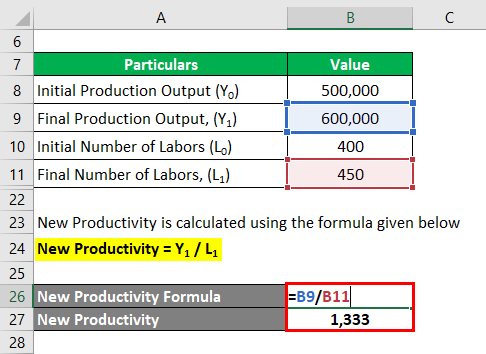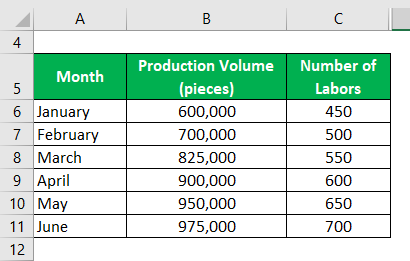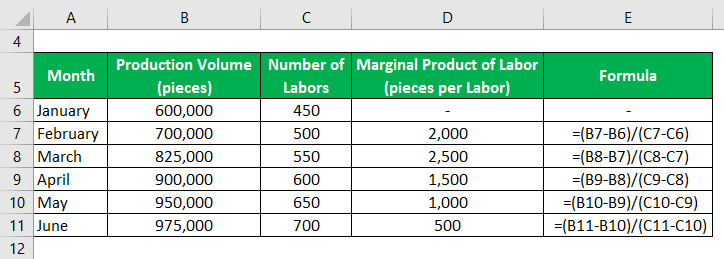Updated July 26, 2023
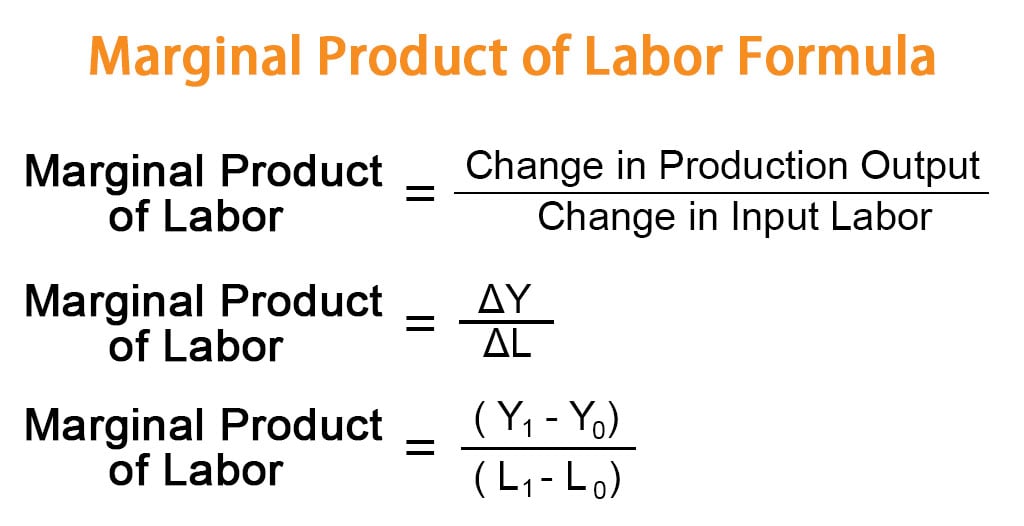
Marginal Product of Labor Formula (Table of Contents)
What is the Marginal Product of Labor Formula?
The term “marginal product of labor” refers to the productivity measure that assesses the change in production output due to a change in the production input, labor in this case.
In other words, the marginal product of labor captures the incremental change in output resulting from an added labor unit. The formula for the marginal product of labor can be derived by dividing the change in production output (ΔY) by the change in input labor (ΔL). The Mathematical representation of the formula is:
or
Further, the formula for the marginal product of labor can be elaborated into
Where,
- Y0 = Initial Production Output,
- Y1 = Final Production Output,
- L0 = Initial Labor Unit
- L1 = Final Labor Unit
Examples of Marginal Product of Labor Formula (With Excel Template)
Let’s take an example to understand the calculation of the Marginal Product of Labor Formula in a better manner.
Marginal Product of Labor Formula – Example #1
Let us take the example of a company, SDF Ltd, which is engaged in the manufacturing of automotive engine parts. Recently, the company’s management conducted a study to understand the impact of increasing workers on the company’s production volume. As per the study, the monthly production volume increased from 500,000 pieces in FY17 to 600,000 pieces in FY18, owing to a corresponding increase in laborers from 400 to 450. Calculate the marginal product of the company’s labor for the newly added labor force. Also, compare the productivity of the new labor force with the existing ones.
Solution:
The formula to calculate the Marginal Product of Labor is as below:
Marginal Product of Labor = (Y1 – Y0) / (L1 – L0)
- Marginal Product of Labor = (600,000 – 500,000) / (450 – 400)
- Marginal Product of Labor = 2,000 pieces per Labor
The formula to calculate Existing Productivity is as below:
Existing Productivity = Y0 / L0
- Existing Productivity = 500,000 / 400
- Existing Productivity = 1,250 pieces per Labor
The formula to calculate New Productivity is as below:
New Productivity = Y1 / L1
- New Productivity = 600,000 / 450
- New Productivity = 1,333 pieces per Labor
Therefore, SDF Ltd.’s marginal product of labor for the new workforce is 2,000 pieces per labor, which has increased the productivity of the entire team from 1,250 pieces per labor to 1,333 pieces per labor.
Marginal Product of Labor Formula – Example #2
Let us take the example of the above company again. Based on its successful recruitment of workers last year, the management has decided to further increase the workforce in a phased manner and track the change in productivity every month. During the first 6 months, the following production volume and workforce data are available. Calculate the marginal product of labor at the end of each month.
Solution:
Marginal Product of Labor is calculated as
February
- Marginal Product of Labor Feb = (700,000 – 600,000) / (500 – 450)
- Marginal Product of Labor Feb = 2,000 pieces per Labor
March
- Marginal Product of Labor Mar = (825,000 – 700,000) / (550 – 500)
- Marginal Product of Labor Mar = 2,500 pieces per Labor
April
- Marginal Product of Labor Apr = (900,000 – 825,000) / (600 – 550)
- Marginal Product of Labor Apr = 1,500 pieces per Labor
May
- Marginal Product of Labor May = (950,000 – 900,000) / (650 – 600)
- Marginal Product of Labor May = 1,000 pieces per Labor
June
- Marginal Product of Labor Jun = (975,000 – 950,000) / (700 – 650)
- Marginal Product of Labor Jun = 500 pieces per Labor
Explanation
The formula for the marginal product of labor can be computed by using the following steps:
Step 1: First, determine the initial production output and the required labor input for that, which are represented by Y0 and L0, respectively.
Step 2: Next, determine the final production output and the corresponding labor input denoted by Y1 and L1, respectively.
Step 3: Next, calculate the change in production output by subtracting the initial output (step 1) from the final output (step 2).
Change in Production Output, ΔY = Y1 – Y0
Step 4: Next, calculate the change in labor input by deducting the initial labor input (step 1) from the final one (step 2).
Change in Labor Input, ΔL = L1 – L0
Step 5: Finally, the formula for the marginal product of labor can be derived by dividing the change in production output (step 3) by the change in input labor (step 4), as shown below.
Marginal Product of Labor = Change in Production Output / Change in Input Labor
Marginal Product of Labor = (Y1 – Y0) / (L1 – L0)
Relevance and Use of Marginal Product of Labor Formula
The concept of the marginal product of labor is important as it can influence major decisions regarding the production level of any company. It should be kept in mind that the marginal product of labor is governed by the law of diminishing marginal returns, which means the marginal productivity will eventually be decreasing after a certain point due to various operational shortcomings. There can be occasions when the marginal productivity becomes negative, which means that the total production level will fall with the addition of any new labor units.
Marginal Product of Labor Formula Calculator
You can use the following Marginal Product of Labor Formula Calculator
| Y0 | |
| Y1 | |
| L0 | |
| L1 | |
| Marginal Product of Labor | |
| Marginal Product of Labor = |
|
|
Recommended Articles
This is a guide to the Marginal Product of Labor Formula. Here we discuss calculating the Marginal Product of Labor along with practical examples. We also provide a Marginal Product of Labor calculator with a downloadable Excel template. You may also look at the following articles to learn more –

